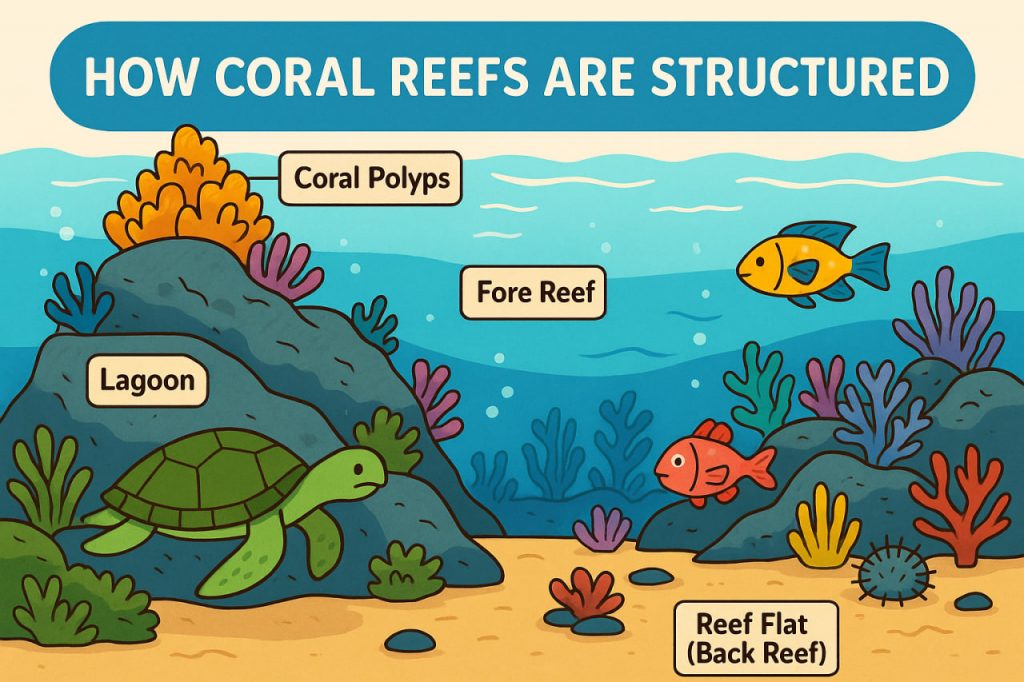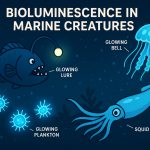Coral reefs are often called the rainforests of the sea, and for good reason. These vibrant underwater ecosystems are home to an extraordinary variety of life. Though they may look like colorful rocks, reefs are actually built by living organisms—coral polyps—that work together over thousands of years to create massive reef structures. Let’s explore how coral reefs are formed, how they function, and why they are so important to life on Earth.
What Are Coral Reefs Made Of?
Coral reefs are built by tiny animals called coral polyps, which belong to the same group as jellyfish.
- Coral polyps live in colonies and secrete a hard outer skeleton made of calcium carbonate.
- As new polyps grow, they build on top of the skeletons of older ones, gradually forming reef structures.
- Most reef-building corals have a symbiotic relationship with microscopic algae called zooxanthellae. These algae live inside the coral and produce food through photosynthesis, while the coral provides shelter.
Layers of a Coral Reef
A typical coral reef consists of several zones:
- Reef Crest
The highest point, where waves break. It receives the most sunlight and supports sturdy coral types. - Fore Reef (Outer Slope)
Faces the open ocean, drops steeply, and hosts many fish and invertebrates. - Reef Flat (Back Reef)
Shallow area between the crest and the lagoon. Often calm and filled with seagrasses and small corals. - Lagoon
Protected, shallow waters between the reef and the shore, rich in juvenile fish and diverse life.
Types of Coral Reefs
- Fringing Reefs: Found close to shorelines, directly attached to land.
- Barrier Reefs: Separated from the shore by a lagoon (e.g., Great Barrier Reef).
- Atolls: Ring-shaped reefs surrounding a lagoon, formed from sunken volcanic islands.
- Patch Reefs: Small, isolated reefs scattered across lagoons or seafloors.
The Biodiversity of Coral Reefs
Though they cover less than 1% of the ocean floor, coral reefs support:
- Over 25% of all marine species
- Thousands of species of fish, mollusks, crustaceans, and more
- Symbiotic relationships between creatures like cleaner fish and their hosts
They provide food, shelter, and breeding grounds for countless organisms.
Why Coral Reefs Are Vital
- Protect coastlines from storms and erosion
- Support fishing and tourism industries
- Act as carbon sinks and help regulate the ocean’s chemistry
- Serve as indicators of ocean health
More than 500 million people depend on reefs for food, income, and protection.
Threats to Coral Reefs
- Climate change and rising sea temperatures cause coral bleaching
- Ocean acidification weakens coral skeletons
- Pollution from runoff, plastics, and chemicals
- Overfishing and destructive fishing practices
- Coastal development and tourism damage
Reefs are incredibly sensitive and may take centuries to recover if damaged.
How We Can Help
- Support marine protected areas
- Avoid buying coral or reef-harming products
- Use reef-safe sunscreens
- Reduce carbon emissions
- Promote sustainable seafood practices
Every small action helps protect these delicate, vital ecosystems.
Glossary
- Coral Polyps: Tiny animals that build reefs by secreting calcium carbonate
- Calcium Carbonate: The hard material forming coral skeletons
- Zooxanthellae: Microscopic algae living inside coral that help produce food
- Coral Bleaching: A stress response where corals expel algae and lose color
- Atoll: A ring-shaped coral reef, island, or series of islets


